Exploring the Role of Women in Artistic Expression in the Middle East
VerifiedAdded on 2020/04/07
|40
|7119
|221
AI Summary
This research paper delves into the significant role that women play in artistic expression within the Middle Eastern context. By examining a variety of art forms such as painting, literature, and cinema, it highlights how these mediums serve as platforms for women to articulate their cultural identities and challenge societal norms. The study draws on historical and contemporary examples, analyzing contributions by prominent female artists who have influenced both regional and global perceptions of the Middle East. Furthermore, it explores theoretical perspectives that frame women's artistic endeavors as acts of resistance and empowerment. Through a multidisciplinary approach, this paper aims to illuminate the transformative power of art in advancing gender equality and cultural understanding.
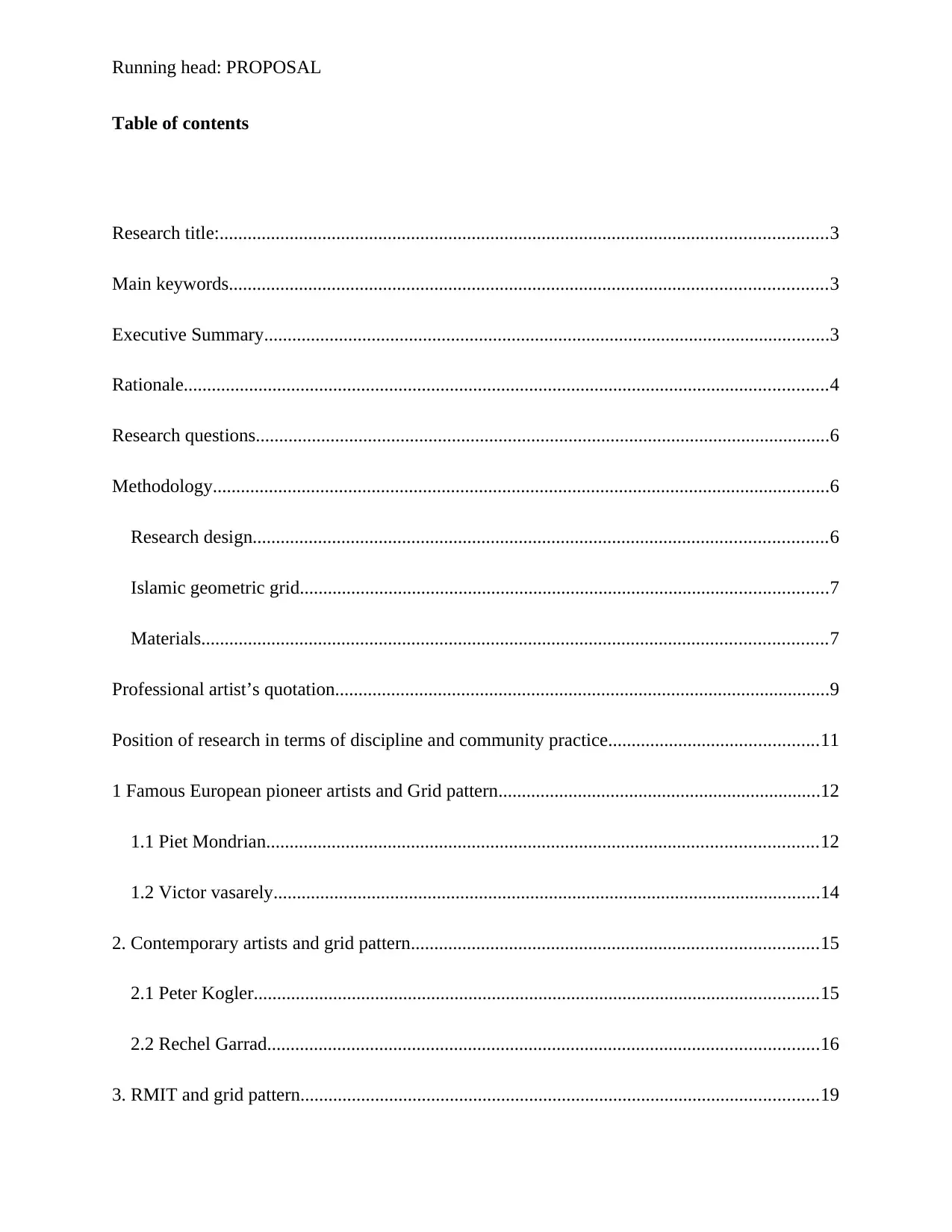
Running head: PROPOSAL
Table of contents
Research title:..................................................................................................................................3
Main keywords................................................................................................................................3
Executive Summary.........................................................................................................................3
Rationale..........................................................................................................................................4
Research questions...........................................................................................................................6
Methodology....................................................................................................................................6
Research design...........................................................................................................................6
Islamic geometric grid.................................................................................................................7
Materials......................................................................................................................................7
Professional artist’s quotation..........................................................................................................9
Position of research in terms of discipline and community practice.............................................11
1 Famous European pioneer artists and Grid pattern.....................................................................12
1.1 Piet Mondrian......................................................................................................................12
1.2 Victor vasarely.....................................................................................................................14
2. Contemporary artists and grid pattern.......................................................................................15
2.1 Peter Kogler.........................................................................................................................15
2.2 Rechel Garrad......................................................................................................................16
3. RMIT and grid pattern...............................................................................................................19
Table of contents
Research title:..................................................................................................................................3
Main keywords................................................................................................................................3
Executive Summary.........................................................................................................................3
Rationale..........................................................................................................................................4
Research questions...........................................................................................................................6
Methodology....................................................................................................................................6
Research design...........................................................................................................................6
Islamic geometric grid.................................................................................................................7
Materials......................................................................................................................................7
Professional artist’s quotation..........................................................................................................9
Position of research in terms of discipline and community practice.............................................11
1 Famous European pioneer artists and Grid pattern.....................................................................12
1.1 Piet Mondrian......................................................................................................................12
1.2 Victor vasarely.....................................................................................................................14
2. Contemporary artists and grid pattern.......................................................................................15
2.1 Peter Kogler.........................................................................................................................15
2.2 Rechel Garrad......................................................................................................................16
3. RMIT and grid pattern...............................................................................................................19
Paraphrase This Document
Need a fresh take? Get an instant paraphrase of this document with our AI Paraphraser
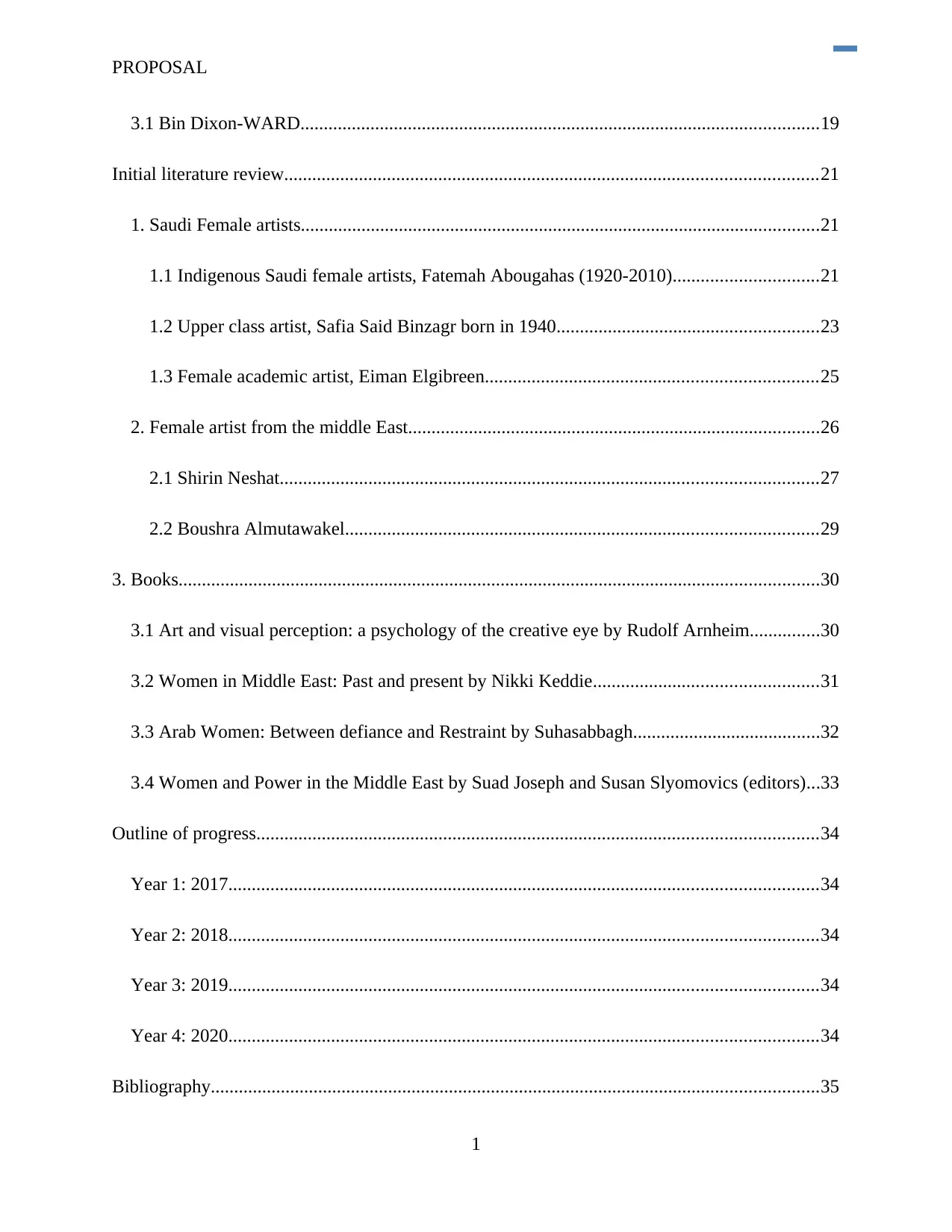
PROPOSAL
3.1 Bin Dixon-WARD...............................................................................................................19
Initial literature review..................................................................................................................21
1. Saudi Female artists...............................................................................................................21
1.1 Indigenous Saudi female artists, Fatemah Abougahas (1920-2010)...............................21
1.2 Upper class artist, Safia Said Binzagr born in 1940........................................................23
1.3 Female academic artist, Eiman Elgibreen.......................................................................25
2. Female artist from the middle East........................................................................................26
2.1 Shirin Neshat...................................................................................................................27
2.2 Boushra Almutawakel.....................................................................................................29
3. Books.........................................................................................................................................30
3.1 Art and visual perception: a psychology of the creative eye by Rudolf Arnheim...............30
3.2 Women in Middle East: Past and present by Nikki Keddie................................................31
3.3 Arab Women: Between defiance and Restraint by Suhasabbagh........................................32
3.4 Women and Power in the Middle East by Suad Joseph and Susan Slyomovics (editors)...33
Outline of progress........................................................................................................................34
Year 1: 2017..............................................................................................................................34
Year 2: 2018..............................................................................................................................34
Year 3: 2019..............................................................................................................................34
Year 4: 2020..............................................................................................................................34
Bibliography..................................................................................................................................35
1
3.1 Bin Dixon-WARD...............................................................................................................19
Initial literature review..................................................................................................................21
1. Saudi Female artists...............................................................................................................21
1.1 Indigenous Saudi female artists, Fatemah Abougahas (1920-2010)...............................21
1.2 Upper class artist, Safia Said Binzagr born in 1940........................................................23
1.3 Female academic artist, Eiman Elgibreen.......................................................................25
2. Female artist from the middle East........................................................................................26
2.1 Shirin Neshat...................................................................................................................27
2.2 Boushra Almutawakel.....................................................................................................29
3. Books.........................................................................................................................................30
3.1 Art and visual perception: a psychology of the creative eye by Rudolf Arnheim...............30
3.2 Women in Middle East: Past and present by Nikki Keddie................................................31
3.3 Arab Women: Between defiance and Restraint by Suhasabbagh........................................32
3.4 Women and Power in the Middle East by Suad Joseph and Susan Slyomovics (editors)...33
Outline of progress........................................................................................................................34
Year 1: 2017..............................................................................................................................34
Year 2: 2018..............................................................................................................................34
Year 3: 2019..............................................................................................................................34
Year 4: 2020..............................................................................................................................34
Bibliography..................................................................................................................................35
1

PROPOSAL
2
2
⊘ This is a preview!⊘
Do you want full access?
Subscribe today to unlock all pages.

Trusted by 1+ million students worldwide
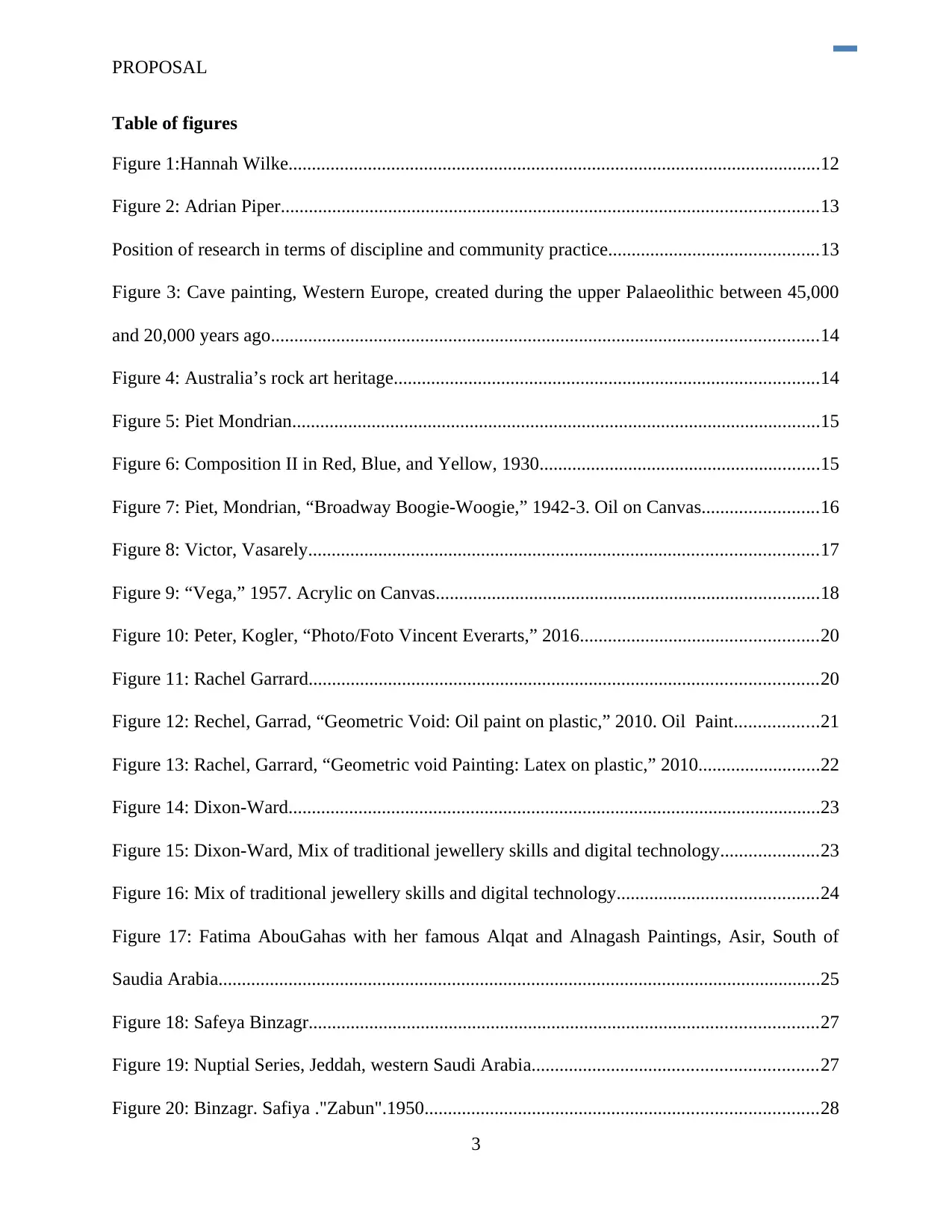
PROPOSAL
Table of figures
Figure 1:Hannah Wilke..................................................................................................................12
Figure 2: Adrian Piper...................................................................................................................13
Position of research in terms of discipline and community practice.............................................13
Figure 3: Cave painting, Western Europe, created during the upper Palaeolithic between 45,000
and 20,000 years ago.....................................................................................................................14
Figure 4: Australia’s rock art heritage...........................................................................................14
Figure 5: Piet Mondrian.................................................................................................................15
Figure 6: Composition II in Red, Blue, and Yellow, 1930............................................................15
Figure 7: Piet, Mondrian, “Broadway Boogie-Woogie,” 1942-3. Oil on Canvas.........................16
Figure 8: Victor, Vasarely.............................................................................................................17
Figure 9: “Vega,” 1957. Acrylic on Canvas..................................................................................18
Figure 10: Peter, Kogler, “Photo/Foto Vincent Everarts,” 2016...................................................20
Figure 11: Rachel Garrard.............................................................................................................20
Figure 12: Rechel, Garrad, “Geometric Void: Oil paint on plastic,” 2010. Oil Paint..................21
Figure 13: Rachel, Garrard, “Geometric void Painting: Latex on plastic,” 2010..........................22
Figure 14: Dixon-Ward..................................................................................................................23
Figure 15: Dixon-Ward, Mix of traditional jewellery skills and digital technology.....................23
Figure 16: Mix of traditional jewellery skills and digital technology...........................................24
Figure 17: Fatima AbouGahas with her famous Alqat and Alnagash Paintings, Asir, South of
Saudia Arabia.................................................................................................................................25
Figure 18: Safeya Binzagr.............................................................................................................27
Figure 19: Nuptial Series, Jeddah, western Saudi Arabia.............................................................27
Figure 20: Binzagr. Safiya ."Zabun".1950....................................................................................28
3
Table of figures
Figure 1:Hannah Wilke..................................................................................................................12
Figure 2: Adrian Piper...................................................................................................................13
Position of research in terms of discipline and community practice.............................................13
Figure 3: Cave painting, Western Europe, created during the upper Palaeolithic between 45,000
and 20,000 years ago.....................................................................................................................14
Figure 4: Australia’s rock art heritage...........................................................................................14
Figure 5: Piet Mondrian.................................................................................................................15
Figure 6: Composition II in Red, Blue, and Yellow, 1930............................................................15
Figure 7: Piet, Mondrian, “Broadway Boogie-Woogie,” 1942-3. Oil on Canvas.........................16
Figure 8: Victor, Vasarely.............................................................................................................17
Figure 9: “Vega,” 1957. Acrylic on Canvas..................................................................................18
Figure 10: Peter, Kogler, “Photo/Foto Vincent Everarts,” 2016...................................................20
Figure 11: Rachel Garrard.............................................................................................................20
Figure 12: Rechel, Garrad, “Geometric Void: Oil paint on plastic,” 2010. Oil Paint..................21
Figure 13: Rachel, Garrard, “Geometric void Painting: Latex on plastic,” 2010..........................22
Figure 14: Dixon-Ward..................................................................................................................23
Figure 15: Dixon-Ward, Mix of traditional jewellery skills and digital technology.....................23
Figure 16: Mix of traditional jewellery skills and digital technology...........................................24
Figure 17: Fatima AbouGahas with her famous Alqat and Alnagash Paintings, Asir, South of
Saudia Arabia.................................................................................................................................25
Figure 18: Safeya Binzagr.............................................................................................................27
Figure 19: Nuptial Series, Jeddah, western Saudi Arabia.............................................................27
Figure 20: Binzagr. Safiya ."Zabun".1950....................................................................................28
3
Paraphrase This Document
Need a fresh take? Get an instant paraphrase of this document with our AI Paraphraser
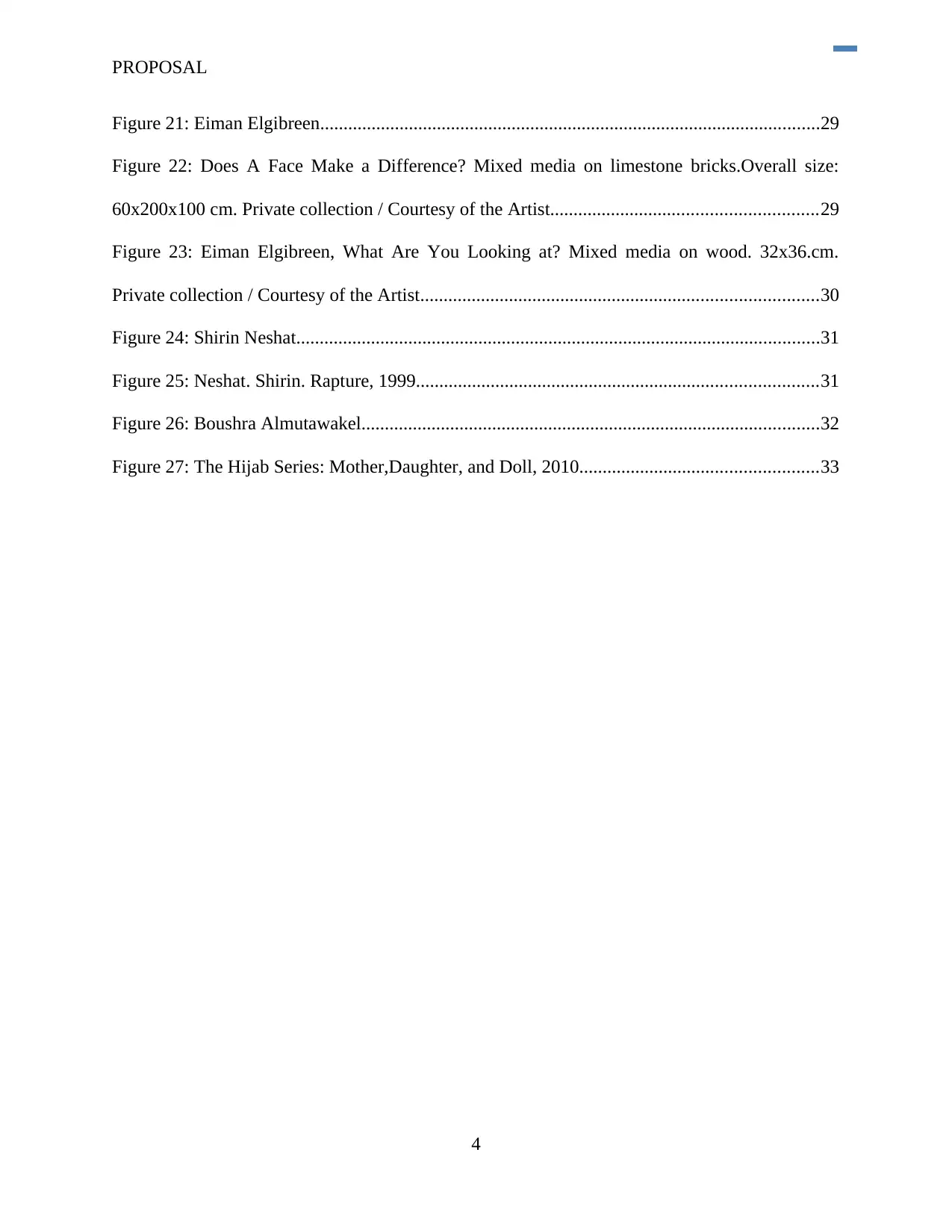
PROPOSAL
Figure 21: Eiman Elgibreen...........................................................................................................29
Figure 22: Does A Face Make a Difference? Mixed media on limestone bricks.Overall size:
60x200x100 cm. Private collection / Courtesy of the Artist.........................................................29
Figure 23: Eiman Elgibreen, What Are You Looking at? Mixed media on wood. 32x36.cm.
Private collection / Courtesy of the Artist.....................................................................................30
Figure 24: Shirin Neshat................................................................................................................31
Figure 25: Neshat. Shirin. Rapture, 1999......................................................................................31
Figure 26: Boushra Almutawakel..................................................................................................32
Figure 27: The Hijab Series: Mother,Daughter, and Doll, 2010...................................................33
4
Figure 21: Eiman Elgibreen...........................................................................................................29
Figure 22: Does A Face Make a Difference? Mixed media on limestone bricks.Overall size:
60x200x100 cm. Private collection / Courtesy of the Artist.........................................................29
Figure 23: Eiman Elgibreen, What Are You Looking at? Mixed media on wood. 32x36.cm.
Private collection / Courtesy of the Artist.....................................................................................30
Figure 24: Shirin Neshat................................................................................................................31
Figure 25: Neshat. Shirin. Rapture, 1999......................................................................................31
Figure 26: Boushra Almutawakel..................................................................................................32
Figure 27: The Hijab Series: Mother,Daughter, and Doll, 2010...................................................33
4
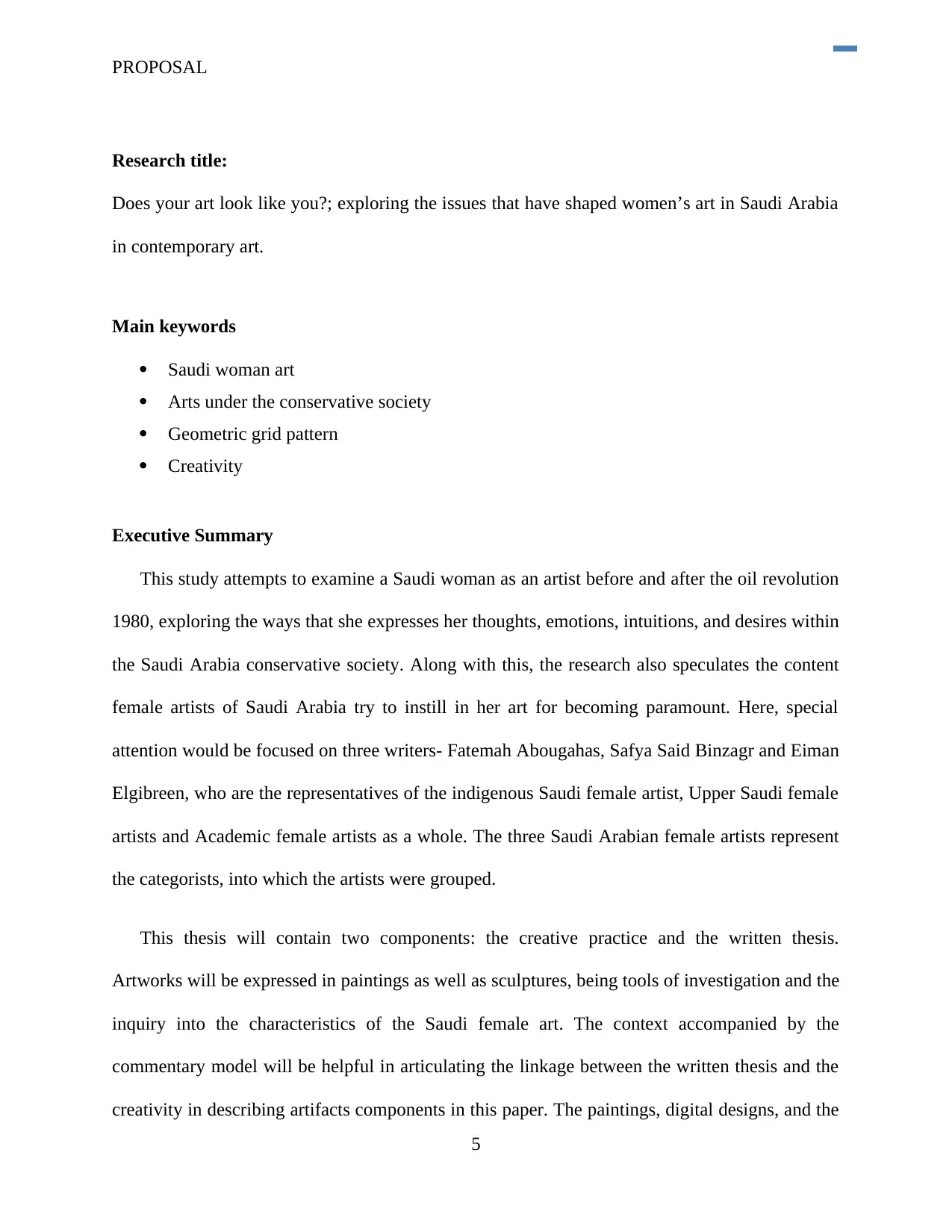
PROPOSAL
Research title:
Does your art look like you?; exploring the issues that have shaped women’s art in Saudi Arabia
in contemporary art.
Main keywords
Saudi woman art
Arts under the conservative society
Geometric grid pattern
Creativity
Executive Summary
This study attempts to examine a Saudi woman as an artist before and after the oil revolution
1980, exploring the ways that she expresses her thoughts, emotions, intuitions, and desires within
the Saudi Arabia conservative society. Along with this, the research also speculates the content
female artists of Saudi Arabia try to instill in her art for becoming paramount. Here, special
attention would be focused on three writers- Fatemah Abougahas, Safya Said Binzagr and Eiman
Elgibreen, who are the representatives of the indigenous Saudi female artist, Upper Saudi female
artists and Academic female artists as a whole. The three Saudi Arabian female artists represent
the categorists, into which the artists were grouped.
This thesis will contain two components: the creative practice and the written thesis.
Artworks will be expressed in paintings as well as sculptures, being tools of investigation and the
inquiry into the characteristics of the Saudi female art. The context accompanied by the
commentary model will be helpful in articulating the linkage between the written thesis and the
creativity in describing artifacts components in this paper. The paintings, digital designs, and the
5
Research title:
Does your art look like you?; exploring the issues that have shaped women’s art in Saudi Arabia
in contemporary art.
Main keywords
Saudi woman art
Arts under the conservative society
Geometric grid pattern
Creativity
Executive Summary
This study attempts to examine a Saudi woman as an artist before and after the oil revolution
1980, exploring the ways that she expresses her thoughts, emotions, intuitions, and desires within
the Saudi Arabia conservative society. Along with this, the research also speculates the content
female artists of Saudi Arabia try to instill in her art for becoming paramount. Here, special
attention would be focused on three writers- Fatemah Abougahas, Safya Said Binzagr and Eiman
Elgibreen, who are the representatives of the indigenous Saudi female artist, Upper Saudi female
artists and Academic female artists as a whole. The three Saudi Arabian female artists represent
the categorists, into which the artists were grouped.
This thesis will contain two components: the creative practice and the written thesis.
Artworks will be expressed in paintings as well as sculptures, being tools of investigation and the
inquiry into the characteristics of the Saudi female art. The context accompanied by the
commentary model will be helpful in articulating the linkage between the written thesis and the
creativity in describing artifacts components in this paper. The paintings, digital designs, and the
5
⊘ This is a preview!⊘
Do you want full access?
Subscribe today to unlock all pages.

Trusted by 1+ million students worldwide
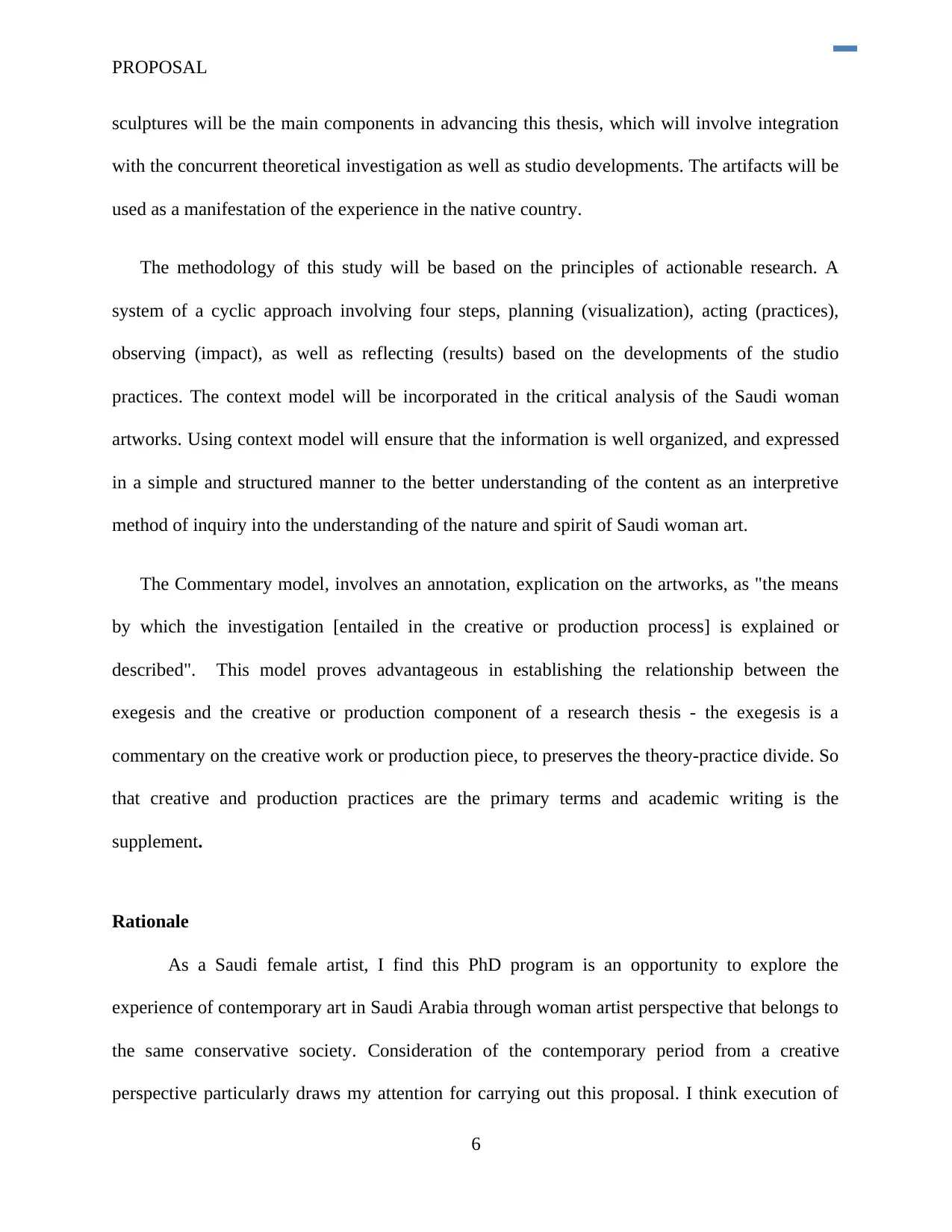
PROPOSAL
sculptures will be the main components in advancing this thesis, which will involve integration
with the concurrent theoretical investigation as well as studio developments. The artifacts will be
used as a manifestation of the experience in the native country.
The methodology of this study will be based on the principles of actionable research. A
system of a cyclic approach involving four steps, planning (visualization), acting (practices),
observing (impact), as well as reflecting (results) based on the developments of the studio
practices. The context model will be incorporated in the critical analysis of the Saudi woman
artworks. Using context model will ensure that the information is well organized, and expressed
in a simple and structured manner to the better understanding of the content as an interpretive
method of inquiry into the understanding of the nature and spirit of Saudi woman art.
The Commentary model, involves an annotation, explication on the artworks, as "the means
by which the investigation [entailed in the creative or production process] is explained or
described". This model proves advantageous in establishing the relationship between the
exegesis and the creative or production component of a research thesis - the exegesis is a
commentary on the creative work or production piece, to preserves the theory-practice divide. So
that creative and production practices are the primary terms and academic writing is the
supplement.
Rationale
As a Saudi female artist, I find this PhD program is an opportunity to explore the
experience of contemporary art in Saudi Arabia through woman artist perspective that belongs to
the same conservative society. Consideration of the contemporary period from a creative
perspective particularly draws my attention for carrying out this proposal. I think execution of
6
sculptures will be the main components in advancing this thesis, which will involve integration
with the concurrent theoretical investigation as well as studio developments. The artifacts will be
used as a manifestation of the experience in the native country.
The methodology of this study will be based on the principles of actionable research. A
system of a cyclic approach involving four steps, planning (visualization), acting (practices),
observing (impact), as well as reflecting (results) based on the developments of the studio
practices. The context model will be incorporated in the critical analysis of the Saudi woman
artworks. Using context model will ensure that the information is well organized, and expressed
in a simple and structured manner to the better understanding of the content as an interpretive
method of inquiry into the understanding of the nature and spirit of Saudi woman art.
The Commentary model, involves an annotation, explication on the artworks, as "the means
by which the investigation [entailed in the creative or production process] is explained or
described". This model proves advantageous in establishing the relationship between the
exegesis and the creative or production component of a research thesis - the exegesis is a
commentary on the creative work or production piece, to preserves the theory-practice divide. So
that creative and production practices are the primary terms and academic writing is the
supplement.
Rationale
As a Saudi female artist, I find this PhD program is an opportunity to explore the
experience of contemporary art in Saudi Arabia through woman artist perspective that belongs to
the same conservative society. Consideration of the contemporary period from a creative
perspective particularly draws my attention for carrying out this proposal. I think execution of
6
Paraphrase This Document
Need a fresh take? Get an instant paraphrase of this document with our AI Paraphraser
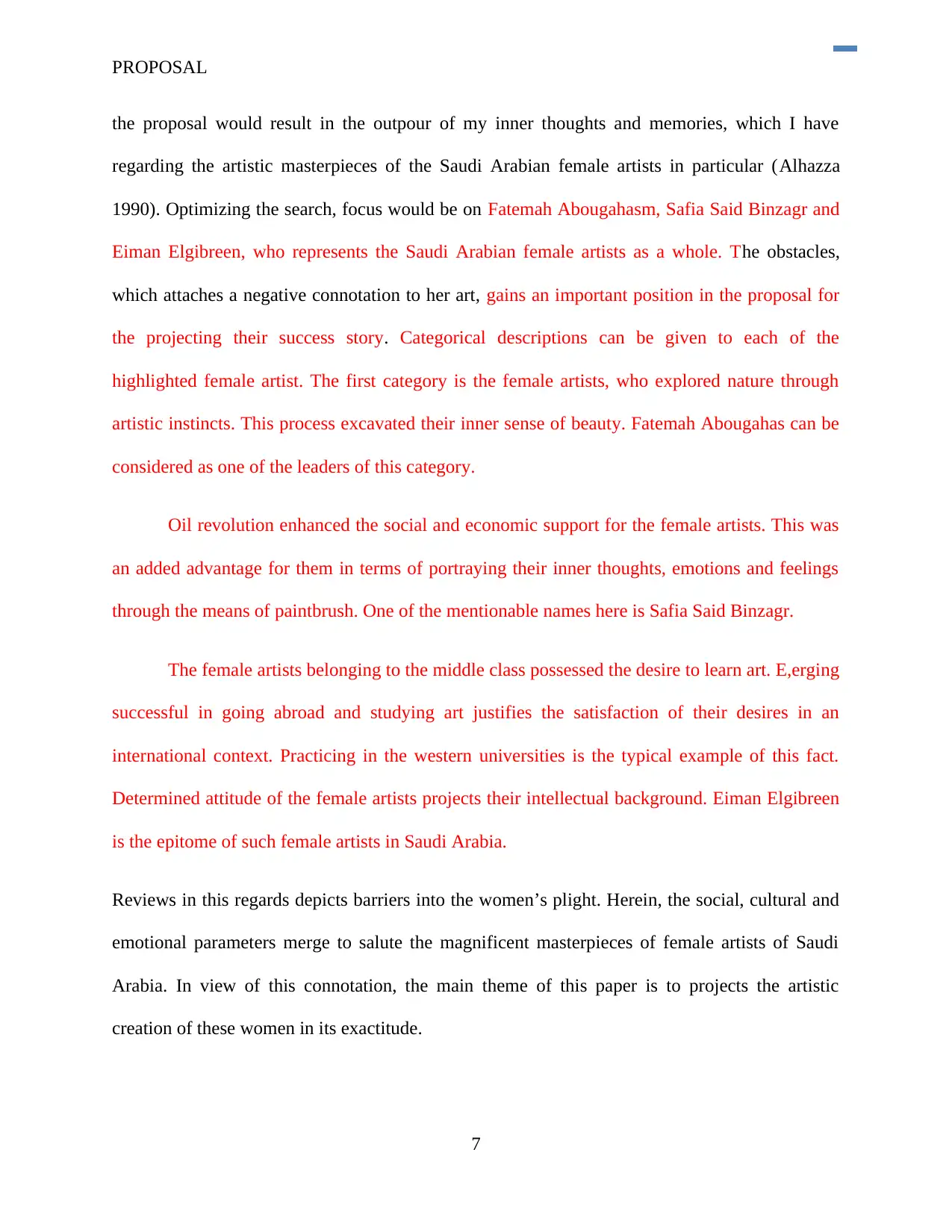
PROPOSAL
the proposal would result in the outpour of my inner thoughts and memories, which I have
regarding the artistic masterpieces of the Saudi Arabian female artists in particular (Alhazza
1990). Optimizing the search, focus would be on Fatemah Abougahasm, Safia Said Binzagr and
Eiman Elgibreen, who represents the Saudi Arabian female artists as a whole. The obstacles,
which attaches a negative connotation to her art, gains an important position in the proposal for
the projecting their success story. Categorical descriptions can be given to each of the
highlighted female artist. The first category is the female artists, who explored nature through
artistic instincts. This process excavated their inner sense of beauty. Fatemah Abougahas can be
considered as one of the leaders of this category.
Oil revolution enhanced the social and economic support for the female artists. This was
an added advantage for them in terms of portraying their inner thoughts, emotions and feelings
through the means of paintbrush. One of the mentionable names here is Safia Said Binzagr.
The female artists belonging to the middle class possessed the desire to learn art. E,erging
successful in going abroad and studying art justifies the satisfaction of their desires in an
international context. Practicing in the western universities is the typical example of this fact.
Determined attitude of the female artists projects their intellectual background. Eiman Elgibreen
is the epitome of such female artists in Saudi Arabia.
Reviews in this regards depicts barriers into the women’s plight. Herein, the social, cultural and
emotional parameters merge to salute the magnificent masterpieces of female artists of Saudi
Arabia. In view of this connotation, the main theme of this paper is to projects the artistic
creation of these women in its exactitude.
7
the proposal would result in the outpour of my inner thoughts and memories, which I have
regarding the artistic masterpieces of the Saudi Arabian female artists in particular (Alhazza
1990). Optimizing the search, focus would be on Fatemah Abougahasm, Safia Said Binzagr and
Eiman Elgibreen, who represents the Saudi Arabian female artists as a whole. The obstacles,
which attaches a negative connotation to her art, gains an important position in the proposal for
the projecting their success story. Categorical descriptions can be given to each of the
highlighted female artist. The first category is the female artists, who explored nature through
artistic instincts. This process excavated their inner sense of beauty. Fatemah Abougahas can be
considered as one of the leaders of this category.
Oil revolution enhanced the social and economic support for the female artists. This was
an added advantage for them in terms of portraying their inner thoughts, emotions and feelings
through the means of paintbrush. One of the mentionable names here is Safia Said Binzagr.
The female artists belonging to the middle class possessed the desire to learn art. E,erging
successful in going abroad and studying art justifies the satisfaction of their desires in an
international context. Practicing in the western universities is the typical example of this fact.
Determined attitude of the female artists projects their intellectual background. Eiman Elgibreen
is the epitome of such female artists in Saudi Arabia.
Reviews in this regards depicts barriers into the women’s plight. Herein, the social, cultural and
emotional parameters merge to salute the magnificent masterpieces of female artists of Saudi
Arabia. In view of this connotation, the main theme of this paper is to projects the artistic
creation of these women in its exactitude.
7
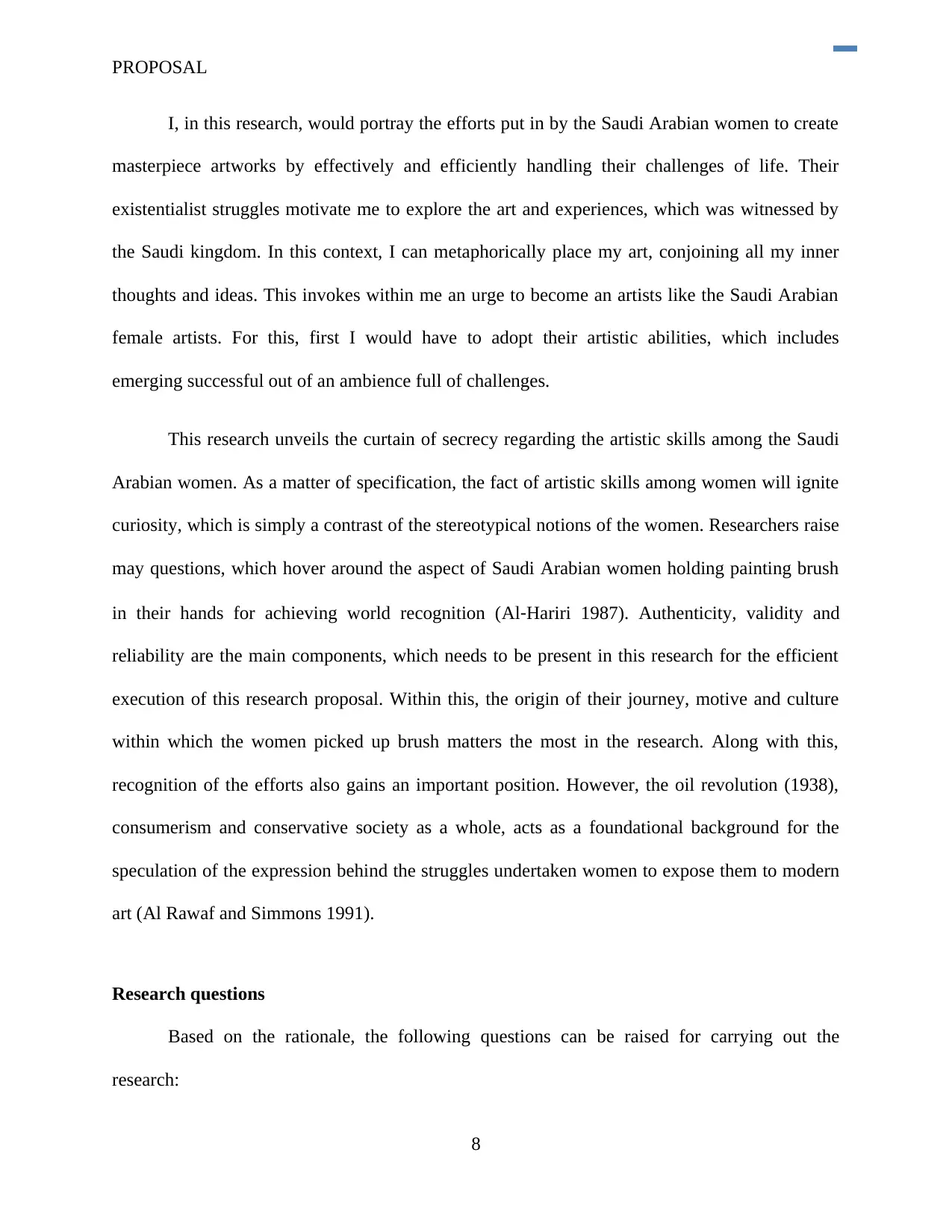
PROPOSAL
I, in this research, would portray the efforts put in by the Saudi Arabian women to create
masterpiece artworks by effectively and efficiently handling their challenges of life. Their
existentialist struggles motivate me to explore the art and experiences, which was witnessed by
the Saudi kingdom. In this context, I can metaphorically place my art, conjoining all my inner
thoughts and ideas. This invokes within me an urge to become an artists like the Saudi Arabian
female artists. For this, first I would have to adopt their artistic abilities, which includes
emerging successful out of an ambience full of challenges.
This research unveils the curtain of secrecy regarding the artistic skills among the Saudi
Arabian women. As a matter of specification, the fact of artistic skills among women will ignite
curiosity, which is simply a contrast of the stereotypical notions of the women. Researchers raise
may questions, which hover around the aspect of Saudi Arabian women holding painting brush
in their hands for achieving world recognition (Al‐Hariri 1987). Authenticity, validity and
reliability are the main components, which needs to be present in this research for the efficient
execution of this research proposal. Within this, the origin of their journey, motive and culture
within which the women picked up brush matters the most in the research. Along with this,
recognition of the efforts also gains an important position. However, the oil revolution (1938),
consumerism and conservative society as a whole, acts as a foundational background for the
speculation of the expression behind the struggles undertaken women to expose them to modern
art (Al Rawaf and Simmons 1991).
Research questions
Based on the rationale, the following questions can be raised for carrying out the
research:
8
I, in this research, would portray the efforts put in by the Saudi Arabian women to create
masterpiece artworks by effectively and efficiently handling their challenges of life. Their
existentialist struggles motivate me to explore the art and experiences, which was witnessed by
the Saudi kingdom. In this context, I can metaphorically place my art, conjoining all my inner
thoughts and ideas. This invokes within me an urge to become an artists like the Saudi Arabian
female artists. For this, first I would have to adopt their artistic abilities, which includes
emerging successful out of an ambience full of challenges.
This research unveils the curtain of secrecy regarding the artistic skills among the Saudi
Arabian women. As a matter of specification, the fact of artistic skills among women will ignite
curiosity, which is simply a contrast of the stereotypical notions of the women. Researchers raise
may questions, which hover around the aspect of Saudi Arabian women holding painting brush
in their hands for achieving world recognition (Al‐Hariri 1987). Authenticity, validity and
reliability are the main components, which needs to be present in this research for the efficient
execution of this research proposal. Within this, the origin of their journey, motive and culture
within which the women picked up brush matters the most in the research. Along with this,
recognition of the efforts also gains an important position. However, the oil revolution (1938),
consumerism and conservative society as a whole, acts as a foundational background for the
speculation of the expression behind the struggles undertaken women to expose them to modern
art (Al Rawaf and Simmons 1991).
Research questions
Based on the rationale, the following questions can be raised for carrying out the
research:
8
⊘ This is a preview!⊘
Do you want full access?
Subscribe today to unlock all pages.

Trusted by 1+ million students worldwide
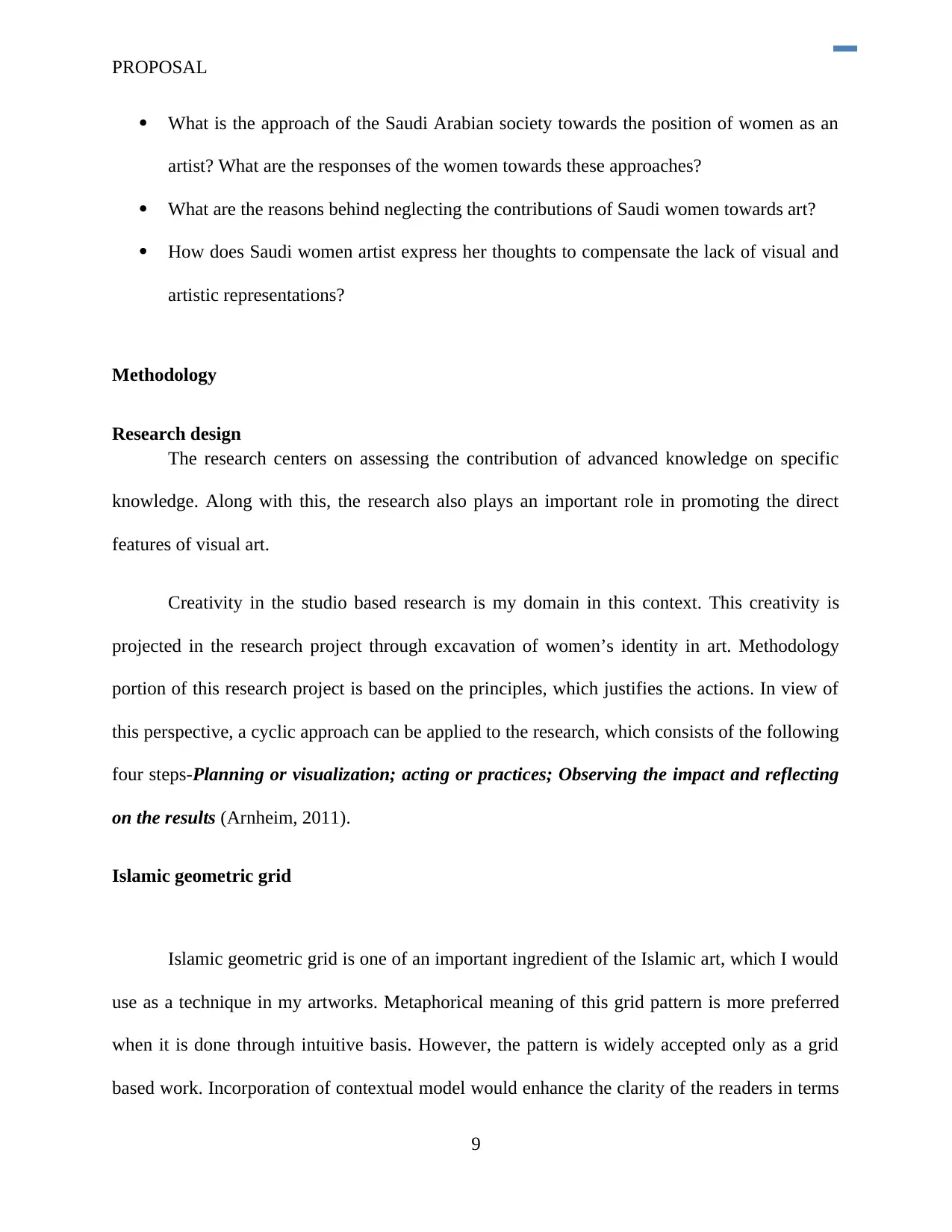
PROPOSAL
What is the approach of the Saudi Arabian society towards the position of women as an
artist? What are the responses of the women towards these approaches?
What are the reasons behind neglecting the contributions of Saudi women towards art?
How does Saudi women artist express her thoughts to compensate the lack of visual and
artistic representations?
Methodology
Research design
The research centers on assessing the contribution of advanced knowledge on specific
knowledge. Along with this, the research also plays an important role in promoting the direct
features of visual art.
Creativity in the studio based research is my domain in this context. This creativity is
projected in the research project through excavation of women’s identity in art. Methodology
portion of this research project is based on the principles, which justifies the actions. In view of
this perspective, a cyclic approach can be applied to the research, which consists of the following
four steps-Planning or visualization; acting or practices; Observing the impact and reflecting
on the results (Arnheim, 2011).
Islamic geometric grid
Islamic geometric grid is one of an important ingredient of the Islamic art, which I would
use as a technique in my artworks. Metaphorical meaning of this grid pattern is more preferred
when it is done through intuitive basis. However, the pattern is widely accepted only as a grid
based work. Incorporation of contextual model would enhance the clarity of the readers in terms
9
What is the approach of the Saudi Arabian society towards the position of women as an
artist? What are the responses of the women towards these approaches?
What are the reasons behind neglecting the contributions of Saudi women towards art?
How does Saudi women artist express her thoughts to compensate the lack of visual and
artistic representations?
Methodology
Research design
The research centers on assessing the contribution of advanced knowledge on specific
knowledge. Along with this, the research also plays an important role in promoting the direct
features of visual art.
Creativity in the studio based research is my domain in this context. This creativity is
projected in the research project through excavation of women’s identity in art. Methodology
portion of this research project is based on the principles, which justifies the actions. In view of
this perspective, a cyclic approach can be applied to the research, which consists of the following
four steps-Planning or visualization; acting or practices; Observing the impact and reflecting
on the results (Arnheim, 2011).
Islamic geometric grid
Islamic geometric grid is one of an important ingredient of the Islamic art, which I would
use as a technique in my artworks. Metaphorical meaning of this grid pattern is more preferred
when it is done through intuitive basis. However, the pattern is widely accepted only as a grid
based work. Incorporation of contextual model would enhance the clarity of the readers in terms
9
Paraphrase This Document
Need a fresh take? Get an instant paraphrase of this document with our AI Paraphraser
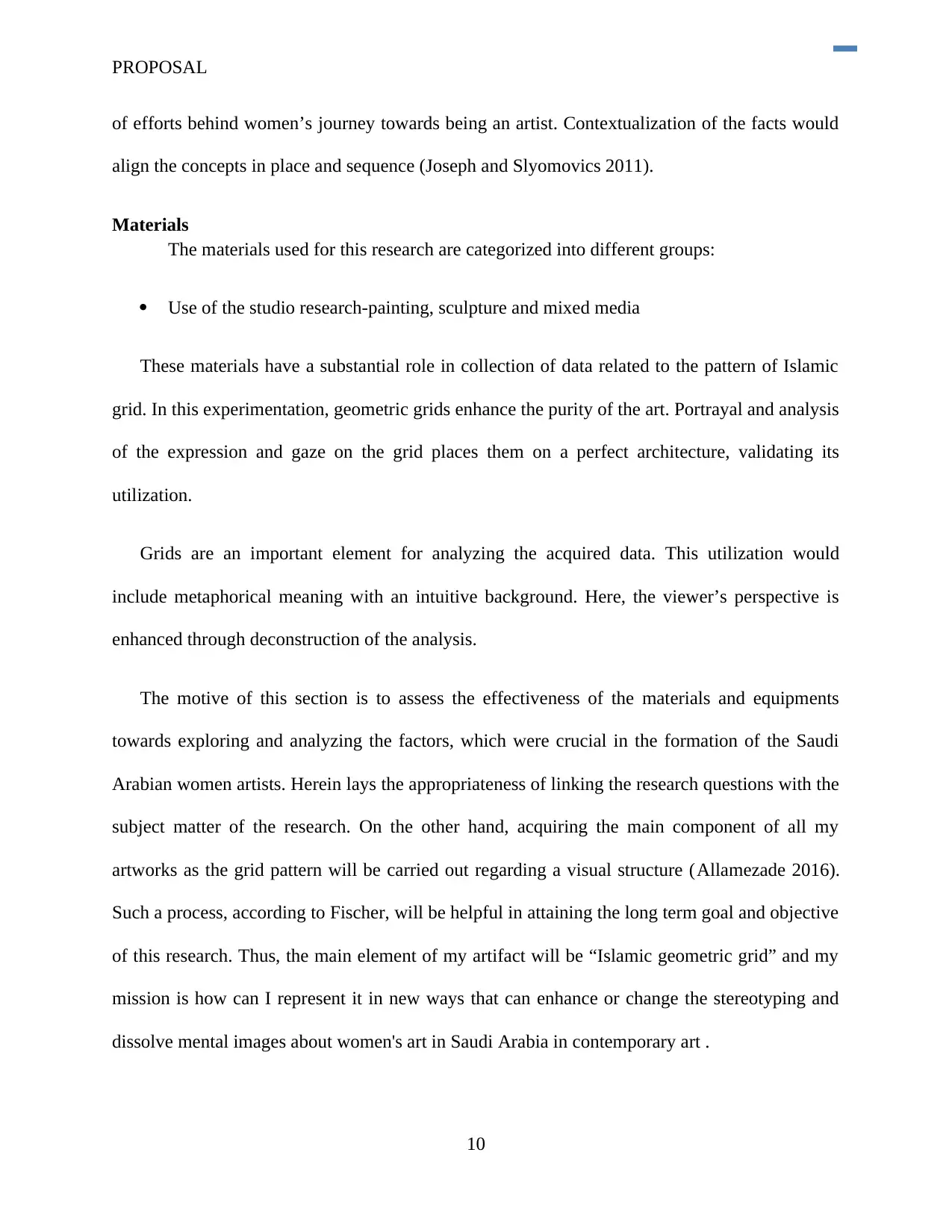
PROPOSAL
of efforts behind women’s journey towards being an artist. Contextualization of the facts would
align the concepts in place and sequence (Joseph and Slyomovics 2011).
Materials
The materials used for this research are categorized into different groups:
Use of the studio research-painting, sculpture and mixed media
These materials have a substantial role in collection of data related to the pattern of Islamic
grid. In this experimentation, geometric grids enhance the purity of the art. Portrayal and analysis
of the expression and gaze on the grid places them on a perfect architecture, validating its
utilization.
Grids are an important element for analyzing the acquired data. This utilization would
include metaphorical meaning with an intuitive background. Here, the viewer’s perspective is
enhanced through deconstruction of the analysis.
The motive of this section is to assess the effectiveness of the materials and equipments
towards exploring and analyzing the factors, which were crucial in the formation of the Saudi
Arabian women artists. Herein lays the appropriateness of linking the research questions with the
subject matter of the research. On the other hand, acquiring the main component of all my
artworks as the grid pattern will be carried out regarding a visual structure (Allamezade 2016).
Such a process, according to Fischer, will be helpful in attaining the long term goal and objective
of this research. Thus, the main element of my artifact will be “Islamic geometric grid” and my
mission is how can I represent it in new ways that can enhance or change the stereotyping and
dissolve mental images about women's art in Saudi Arabia in contemporary art .
10
of efforts behind women’s journey towards being an artist. Contextualization of the facts would
align the concepts in place and sequence (Joseph and Slyomovics 2011).
Materials
The materials used for this research are categorized into different groups:
Use of the studio research-painting, sculpture and mixed media
These materials have a substantial role in collection of data related to the pattern of Islamic
grid. In this experimentation, geometric grids enhance the purity of the art. Portrayal and analysis
of the expression and gaze on the grid places them on a perfect architecture, validating its
utilization.
Grids are an important element for analyzing the acquired data. This utilization would
include metaphorical meaning with an intuitive background. Here, the viewer’s perspective is
enhanced through deconstruction of the analysis.
The motive of this section is to assess the effectiveness of the materials and equipments
towards exploring and analyzing the factors, which were crucial in the formation of the Saudi
Arabian women artists. Herein lays the appropriateness of linking the research questions with the
subject matter of the research. On the other hand, acquiring the main component of all my
artworks as the grid pattern will be carried out regarding a visual structure (Allamezade 2016).
Such a process, according to Fischer, will be helpful in attaining the long term goal and objective
of this research. Thus, the main element of my artifact will be “Islamic geometric grid” and my
mission is how can I represent it in new ways that can enhance or change the stereotyping and
dissolve mental images about women's art in Saudi Arabia in contemporary art .
10
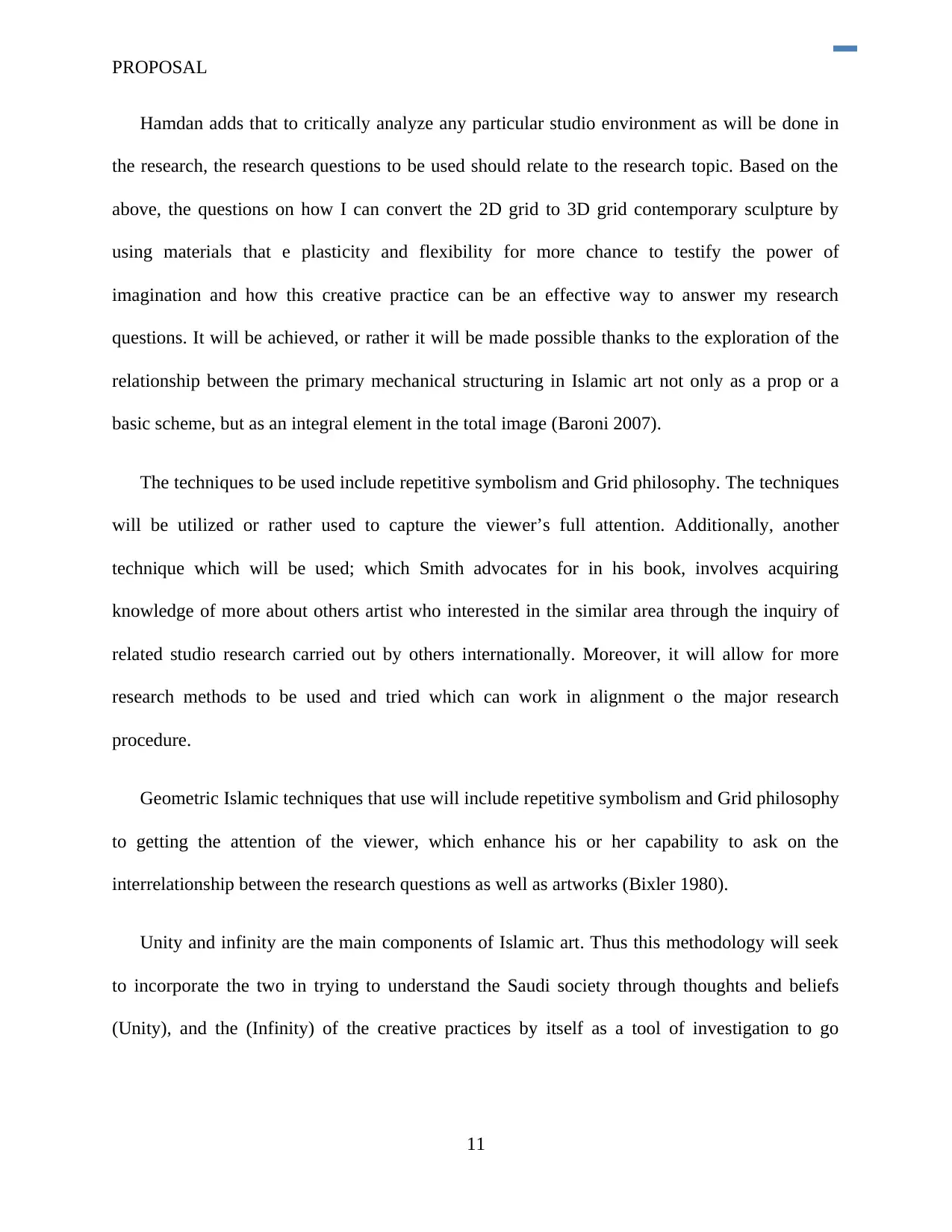
PROPOSAL
Hamdan adds that to critically analyze any particular studio environment as will be done in
the research, the research questions to be used should relate to the research topic. Based on the
above, the questions on how I can convert the 2D grid to 3D grid contemporary sculpture by
using materials that e plasticity and flexibility for more chance to testify the power of
imagination and how this creative practice can be an effective way to answer my research
questions. It will be achieved, or rather it will be made possible thanks to the exploration of the
relationship between the primary mechanical structuring in Islamic art not only as a prop or a
basic scheme, but as an integral element in the total image (Baroni 2007).
The techniques to be used include repetitive symbolism and Grid philosophy. The techniques
will be utilized or rather used to capture the viewer’s full attention. Additionally, another
technique which will be used; which Smith advocates for in his book, involves acquiring
knowledge of more about others artist who interested in the similar area through the inquiry of
related studio research carried out by others internationally. Moreover, it will allow for more
research methods to be used and tried which can work in alignment o the major research
procedure.
Geometric Islamic techniques that use will include repetitive symbolism and Grid philosophy
to getting the attention of the viewer, which enhance his or her capability to ask on the
interrelationship between the research questions as well as artworks (Bixler 1980).
Unity and infinity are the main components of Islamic art. Thus this methodology will seek
to incorporate the two in trying to understand the Saudi society through thoughts and beliefs
(Unity), and the (Infinity) of the creative practices by itself as a tool of investigation to go
11
Hamdan adds that to critically analyze any particular studio environment as will be done in
the research, the research questions to be used should relate to the research topic. Based on the
above, the questions on how I can convert the 2D grid to 3D grid contemporary sculpture by
using materials that e plasticity and flexibility for more chance to testify the power of
imagination and how this creative practice can be an effective way to answer my research
questions. It will be achieved, or rather it will be made possible thanks to the exploration of the
relationship between the primary mechanical structuring in Islamic art not only as a prop or a
basic scheme, but as an integral element in the total image (Baroni 2007).
The techniques to be used include repetitive symbolism and Grid philosophy. The techniques
will be utilized or rather used to capture the viewer’s full attention. Additionally, another
technique which will be used; which Smith advocates for in his book, involves acquiring
knowledge of more about others artist who interested in the similar area through the inquiry of
related studio research carried out by others internationally. Moreover, it will allow for more
research methods to be used and tried which can work in alignment o the major research
procedure.
Geometric Islamic techniques that use will include repetitive symbolism and Grid philosophy
to getting the attention of the viewer, which enhance his or her capability to ask on the
interrelationship between the research questions as well as artworks (Bixler 1980).
Unity and infinity are the main components of Islamic art. Thus this methodology will seek
to incorporate the two in trying to understand the Saudi society through thoughts and beliefs
(Unity), and the (Infinity) of the creative practices by itself as a tool of investigation to go
11
⊘ This is a preview!⊘
Do you want full access?
Subscribe today to unlock all pages.

Trusted by 1+ million students worldwide
1 out of 40
Your All-in-One AI-Powered Toolkit for Academic Success.
+13062052269
info@desklib.com
Available 24*7 on WhatsApp / Email
![[object Object]](/_next/static/media/star-bottom.7253800d.svg)
Unlock your academic potential
Copyright © 2020–2025 A2Z Services. All Rights Reserved. Developed and managed by ZUCOL.
